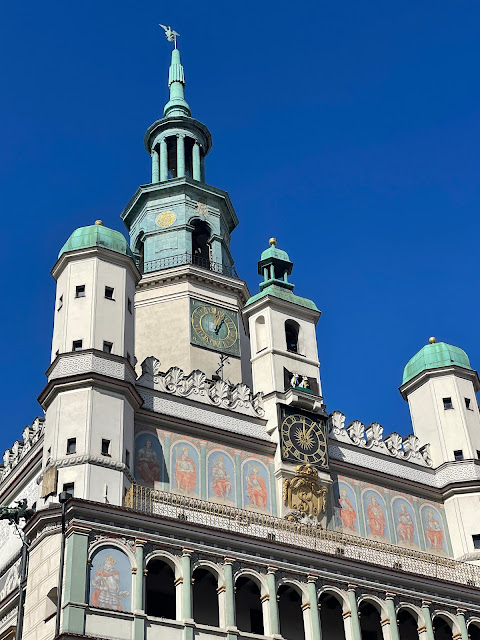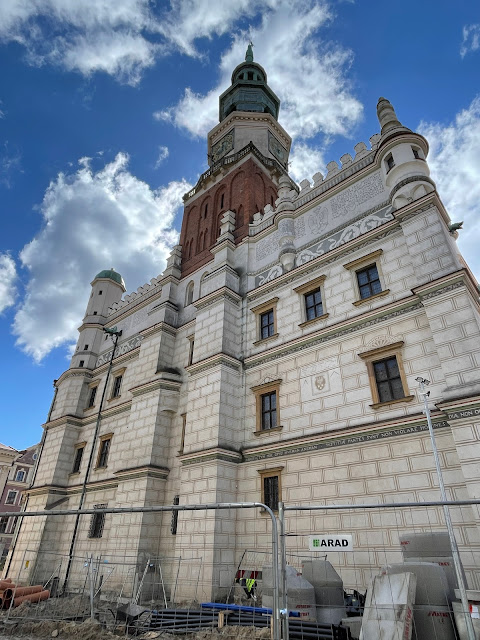Travel Date: 2023/03/24 ~ 04/12
Poznań: 2023/04/03
It's our first time visiting Poznań, and it's a beautiful city with plenty of historical places to explore. We were particularly excited to try some of the special sweets that are unique to this area. Unfortunately, due to the ongoing road renovations, we couldn't fully appreciate the city's beauty. Nevertheless, we managed to visit two castles, the Old Town Hall, the Cathedral, and indulge in St. Martin's Croissant, which was delightful.
The weather during our visit was quite cold, with temperatures below zero degrees Celsius. The freezing temperatures made it challenging to fully enjoy our time as our hands turned red, and our fingers became numb, making it difficult to hold things. Our son, Adrian, complained a lot about the cold, which added to the challenges.
Poznań is a 2.5-hour drive from my aunt's place, and we took the highway, part of which required a toll fee. We paid 56zl for the trip, which is approximately 400NT. Driving in Poland has been a pleasant experience, with less traffic compared to what we're used to in Taiwan. Unlike the scooters that often appear unexpectedly from various directions in Taiwan, driving here feels more organized. It's amusing to think that even expressing a concern about traffic in Taiwan can sometimes lead to comments like, "If you don't like it, go back to your country." Nonetheless, we appreciate the smoother driving experience in Poland.
Check out my YouTube video
Royal Castle (Zamek Królewski)
The Royal Castle in Poznań, known as Zamek Królewski w Poznaniu in Polish, has a rich history dating back to 1249 during the reign of Przemysł I. Although it was largely destroyed during World War II, it has been partially rebuilt. The castle is located on a hill called Góra Zamkowa (Castle Mountain), also known as Góra Przemysława (Hill of Przemysł or Przemysław).
Initially, a habitable tower made of bricks with a well inside was constructed by Przemysł I, and the rest of the hill was surrounded by a rampart with a palisade. In the late 13th century, a small ducal residence was integrated into the city walls. Przemysł II, the son of Przemysł I, had the vision of building a larger castle suitable for a king. Although he became king of Poland in 1295, he was assassinated a year later, and the castle remained unfinished. The work started by Przemysł was continued by the Piast dynasty ruling in Greater Poland, and it was completed before 1337. The castle served as the residence of Prince Casimir, the governor of Greater Poland at the time.
By 1337, the Royal Castle in Poznań was the largest castle in the Polish Kingdom, modeled after the palatium of Henry I the Bearded in Legnica. It consisted of a tower built by Przemysł I and a large building with three levels and a basement. The castle featured basements used as prisons and for wine storage, charring rooms on the ground floor, representative chambers on the first floor, and a chamber for 2000 guests on the second floor. It also had a defense tower at the south end. Throughout the centuries, the castle underwent various renovations and repairs.
Unfortunately, the castle was severely damaged multiple times. It burned during the fire of Poznań in 1536 and was later destroyed during the Swedish invasion, sacked in 1704, and demolished in 1716. It was partially renovated in 1721 but suffered further devastation. In 1804, the Prussians demolished the southern part of the castle, replacing it with new buildings. Over the years, it served different purposes such as an archive, the office of the local Regierungsbezirk, the seat of the Court of Appeals, and the State Archive.
The castle faced more destruction during World War II when it was demolished during the battle for the Poznań Citadel in 1945. However, in the years 1959-1964, the Raczyński's archive and part of the Prussian building were rebuilt. Today, the surviving parts of the castle house the Museum of Utilitary Art (Muzeum Sztuki Użytkowej). Reconstruction work began in 2010 to restore the demolished sections and carefully restore the remaining buildings.
Despite the damage and destruction, some elements from the original construction still remain, such as the two-meter-wide supports from the thirteenth and fourteenth centuries, the inner walls of the basement, and parts of the western and eastern walls. Plaques commemorating significant events and anniversaries are also present on the surviving part of the castle.
Billy Goats in Old Market Square
Located in the heart of the Old Market Square in Poznań is the magnificent Renaissance Town Hall, considered one of the most beautiful Renaissance town halls north of the Alps. One of its notable features is the clock with mechanical billy goats that was installed in 1551. Every day at noon, as the clock strikes, a door opens on the tower above the clock, and two billy goats emerge. Controlled by the clock's mechanism, they butt their horned heads 12 times.
There is a fascinating legend associated with the installation of the billy goats. According to the legend, when the clock was completed, it was meant to be presented to the councilmen and the governor of Poznań. A grand feast was prepared for the occasion, but unfortunately, one of the cooks accidentally burned the haunch of venison that was meant to be served. In an attempt to salvage the situation, the cook stole two billy goats with the intention of roasting and serving them instead. However, the goats managed to escape and found their way to the ledge of the Town Hall tower.
When the esteemed guests arrived, they were surprised to see the two billy goats butting heads on the tower's ledge. In order to save face and turn the situation into a spectacle, the governor commanded that mechanical billy goats be attached to the clock's mechanism. This addition allowed the goats to continue their symbolic butting of heads as part of the daily clock performance, delighting locals and visitors alike with their unique display.
St Martin’s Croissant (Rogale Świętomarcińskie)
A St Martin's Croissant is a renowned Polish pastry made with semi-puff pastry and filled with white poppy seeds. It has gained significant popularity and is now recognized as one of the most famous Polish pastries. In fact, it is protected by the European Union Certificate of Authenticity, ensuring that its production remains exclusive to the Wielkopolska region of Poland and adheres to strict guidelines.
The tradition of baking St Martin's Croissants dates back to the 19th century and is closely associated with the November 11th church fair held at St Martin's parish. The tradition began when a pastry maker in Poznań responded to the parish priest's call for donations for the poor by making three trays of croissants and bringing them to the church. Other pastry makers were inspired by this act of generosity and soon followed suit. Thus, the tradition of eating St Martin's Croissants during the fair was born and has been continued ever since.
On St Martin's Day, which falls on November 11th, both locals and tourists in Poznań consume approximately 250 tonnes of croissants, equivalent to about 1.25 million individual pastries. It has become a cherished culinary tradition in the city.
To delve deeper into the history and secrets of St Martin's Croissants, you can visit the Poznań Croissant Museum and Experience. Housed in a beautiful Renaissance tenement house located opposite the Town Hall, the museum offers live shows presented by locals, where you can learn about the making of croissants and other prideful specialties of Poznań. As part of the experience, croissant tasting is included, allowing you to savor the delicious flavors firsthand.
We indulged in croissants from H.P. Cukiernia Hanna Piskorska, and they were truly delicious!
Poznań Imperial Castle
The former Imperial Castle, located in Poznań, is the last and youngest monarchical residence in Europe. It was constructed at the beginning of the 20th century for German Emperor Wilhelm II. After World War I, the castle served various purposes, including housing the Mathematical Department of Poznań University, whose alumni successfully broke the code of the German Enigma ciphering machine. During World War II, the castle underwent extensive remodeling and became the official quarters of Adolf Hitler. Today, it functions as a cultural facility, hosting exhibitions, a cinema, and a children's animation theater.
Visitors can explore the castle with a guide, allowing them to discover interesting nooks and crannies not accessible otherwise. One of the highlights is the original 5-ton throne of Wilhelm II. Construction of the castle began in 1905 and was completed in 1910. Following Poland's capitulation in 1939, the castle was transformed into Hitler's residence. Albert Speer oversaw the reconstruction during the German occupation, converting the chapel into Hitler's private cabinet and transforming the throne room into an audience hall. A bunker capable of accommodating 375 people was also constructed beneath the castle. However, construction was halted in 1943 due to setbacks on the Eastern Front.
During the Battle of Posen in 1945, the castle temporarily served as a prisoner of war camp for German soldiers. The name of the structure is somewhat misleading, as it is more of a palace than a castle. The Polish name emphasizes Wilhelm II's status as Emperor of Germany, while the German name refers to him as the King of Prussia. The castle's location in the Imperial District of Poznań was strategic, as it was part of a larger plan to create a new Germanic urban core in the city. The castle was designed in Neo-Romanesque style, chosen by Wilhelm II to symbolize the glory of the Holy Roman Empire.
The main building consists of two wings: the larger western wing with apartments and the eastern wing with representative rooms. The western wing housed the rooms of the Court Marshal, Chamberlain, and other members of the imperial court on the ground floor, while the Emperor and Empress occupied the first-floor apartments. A private chapel in Byzantine style, designed by August Oetken, was located in a tower. The representative wing featured the impressive Throne Room in Byzantine style, illuminated by large windows and adorned with statues of Holy Roman Emperors. The northern part of the complex housed service rooms, a garage, a stable, and a coach house, surrounding a rose garden with a fountain inspired by the Fountain of the Lions in the Alhambra in Granada, Spain.
Poznań Cathedral
Discover the beginnings of the Polish state in the underground of the Cathedral on Cathedral Island in Poznań. The underground of the cathedral church houses the relics of the first Polish cathedral from the 10th century, as well as the tombs of Poland's first rulers, Mieszko I and Bolesław the Brave. There is also a supposed baptistery from 966. Adjacent to the cathedral is the state-of-the-art interactive Heritage Center of Cathedral Island called "Brama Poznania."
Cathedral Island, formerly known as Ostrów Tumski, is one of the most enchanting parts of Poznań. With the cathedral overlooking the area, a small Church of Saint Mary the Virgin, cobblestone streets leading up to the former ramparts, and historic garden homesteads of cathedral canons, it is a peaceful and serene enclave where time seems to slow down.
Other notable places to visit on Cathedral Island include the Archdiocesan Museum, which houses St. Peter's sword and is located in the former Lubrański Academy, as well as the Genius Loci Archeological Reserve.
The Archcathedral Basilica of St. Peter and St. Paul in Poznań is one of the oldest churches in Poland and the oldest Polish cathedral, dating back to the 10th century. It is situated on Cathedral Island northeast of the city center.
The cathedral was originally constructed in the latter half of the 10th century within the fortified settlement of Poznań, known as Ostrów Tumski. This area served as one of the main political centers in the early Polish state and included a ducal palace. The palace, which is now excavated beneath the Church of the Virgin Mary in front of the cathedral, contained a chapel, possibly built for Dobrawa, the Christian wife of Mieszko I, Poland's first historical ruler. Mieszko I was baptized in 966, possibly in Poznań, marking a significant event in the Christianization of Poland and the consolidation of the state. The cathedral was built around this time and was elevated to the status of a cathedral in 968 when the first missionary bishop, Bishop Jordan, arrived in Poland.
The cathedral adopted Saint Peter as its patron, as it was the first cathedral in the country and had the right to share the same patron as St. Peter's Basilica in the Vatican. The original pre-Romanesque church was approximately 48 meters long, and remnants of this building can still be seen in the basements of the current basilica. This first church stood for about seventy years until the period of pagan reaction and the raid of Bohemian duke Bretislav I (1034–1038). The cathedral was then rebuilt in the Romanesque style, and remnants of this can be observed in the southern tower.
During the 14th and 15th centuries, the church underwent reconstruction in the Gothic style, with the addition of a crown of chapels. A significant fire in 1622 caused severe damage, leading to a complete renovation of the cathedral in the Baroque style. Another major fire occurred in 1772, after which the church was rebuilt in the Neo-Classical style. In 1821, Pope Pius VII elevated the cathedral to the status of a Metropolitan Archcathedral and added Saint Paul as the second patron. The cathedral suffered its last major fire on February 15, 1945, during the liberation of the city from German occupation. The damage was significant, prompting conservators to restore the cathedral to its Gothic roots, utilizing medieval relics uncovered by the fire. The cathedral was reopened on June 29, 1956. In 1962, Pope John XXIII bestowed the title of minor basilica upon the church.




































0 komentarze:
Post a Comment